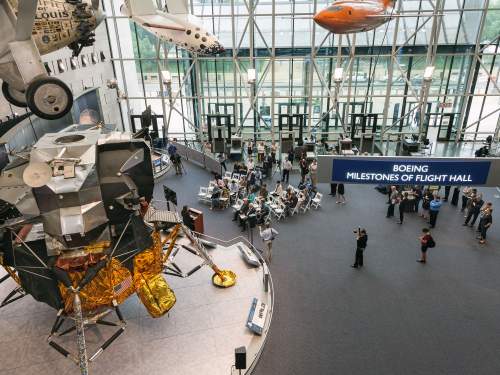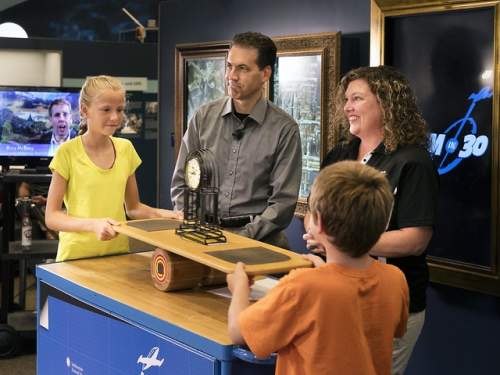As a public health precaution, the Steven F. Udvar-Hazy Center and the Museum in DC are temporarily closed. See our COVID-19 message.
Lunar Module LM-2
-

- CCO - Creative Commons (CC0 1.0)
- This media is in the public domain (free of copyright restrictions). You can copy, modify, and distribute this work without contacting the Smithsonian. For more information, visit the Smithsonian's Terms of Use page.
- IIIF provides researchers rich metadata and image viewing options for comparison of works across cultural heritage collections. More - https://iiif.si.edu
- View Manifest
- View in Mirador Viewer
Lunar Module LM-2
Two-stage vehicle; ascent stage with 3 windows (two forward, one overhead), two hatches, docking mechanism; descent stage module with 4 legs; modified to appear like Apollo 11 Lunar Module "Eagle"
-

- CCO - Creative Commons (CC0 1.0)
- This media is in the public domain (free of copyright restrictions). You can copy, modify, and distribute this work without contacting the Smithsonian. For more information, visit the Smithsonian's Terms of Use page.
- IIIF provides researchers rich metadata and image viewing options for comparison of works across cultural heritage collections. More - https://iiif.si.edu
- View Manifest
- View in Mirador Viewer
Lunar Module LM-2
Two-stage vehicle; ascent stage with 3 windows (two forward, one overhead), two hatches, docking mechanism; descent stage module with 4 legs; modified to appear like Apollo 11 Lunar Module "Eagle"
-

- CCO - Creative Commons (CC0 1.0)
- This media is in the public domain (free of copyright restrictions). You can copy, modify, and distribute this work without contacting the Smithsonian. For more information, visit the Smithsonian's Terms of Use page.
- IIIF provides researchers rich metadata and image viewing options for comparison of works across cultural heritage collections. More - https://iiif.si.edu
- View Manifest
- View in Mirador Viewer
Lunar Module LM-2
Two-stage vehicle; ascent stage with 3 windows (two forward, one overhead), two hatches, docking mechanism; descent stage module with 4 legs; modified to appear like Apollo 11 Lunar Module "Eagle"
-

- CCO - Creative Commons (CC0 1.0)
- This media is in the public domain (free of copyright restrictions). You can copy, modify, and distribute this work without contacting the Smithsonian. For more information, visit the Smithsonian's Terms of Use page.
- IIIF provides researchers rich metadata and image viewing options for comparison of works across cultural heritage collections. More - https://iiif.si.edu
- View Manifest
- View in Mirador Viewer
Lunar Module LM-2
Two-stage vehicle; ascent stage with 3 windows (two forward, one overhead), two hatches, docking mechanism; descent stage module with 4 legs; modified to appear like Apollo 11 Lunar Module "Eagle"
-

- CCO - Creative Commons (CC0 1.0)
- This media is in the public domain (free of copyright restrictions). You can copy, modify, and distribute this work without contacting the Smithsonian. For more information, visit the Smithsonian's Terms of Use page.
- IIIF provides researchers rich metadata and image viewing options for comparison of works across cultural heritage collections. More - https://iiif.si.edu
- View Manifest
- View in Mirador Viewer
Lunar Module LM-2
Two-stage vehicle; ascent stage with 3 windows (two forward, one overhead), two hatches, docking mechanism; descent stage module with 4 legs; modified to appear like Apollo 11 Lunar Module "Eagle"
-

- CCO - Creative Commons (CC0 1.0)
- This media is in the public domain (free of copyright restrictions). You can copy, modify, and distribute this work without contacting the Smithsonian. For more information, visit the Smithsonian's Terms of Use page.
- IIIF provides researchers rich metadata and image viewing options for comparison of works across cultural heritage collections. More - https://iiif.si.edu
- View Manifest
- View in Mirador Viewer
Lunar Module LM-2
Two-stage vehicle; ascent stage with 3 windows (two forward, one overhead), two hatches, docking mechanism; descent stage module with 4 legs; modified to appear like Apollo 11 Lunar Module "Eagle"
-

- CCO - Creative Commons (CC0 1.0)
- This media is in the public domain (free of copyright restrictions). You can copy, modify, and distribute this work without contacting the Smithsonian. For more information, visit the Smithsonian's Terms of Use page.
- IIIF provides researchers rich metadata and image viewing options for comparison of works across cultural heritage collections. More - https://iiif.si.edu
- View Manifest
- View in Mirador Viewer
Lunar Module LM-2
Two-stage vehicle; ascent stage with 3 windows (two forward, one overhead), two hatches, docking mechanism; descent stage module with 4 legs; modified to appear like Apollo 11 Lunar Module "Eagle"
-

Lunar Module 2 (LM-2)
LM 2 was built for a second unmanned Earth-orbit test flight. Because the test flight of LM 1, named Apollo 5, was so successful, a second mission was deemed unnecessary.
-

Apollo Lunar Module
Apollo Lunar Module number 2 on display in the Lunar Exploration Vehicles gallery at the Museum in Washington, DC.
-

Building the Lunar Module
Most of the Apollo hardware was built in the South or the West of the United States, but the Lunar Modules were built by Grumman Aircraft Engineering Corporation, in Bethpage, Long Island, New York.
-

Grumman Technicians Working on the Lunar Module
Grumman technicians built the Lunar Module. Grumman was a chief supplier of aircraft for the U.S. Navy. As such, it was accustomed to designing craft that could withstand the hard landings on an aircraft carrier. That experience probably served Grumman well as they designed the Lunar Lander, intended to be sturdy enough to land on the Moon’s surface.
-

LM-2 Detail
A detail of the Lunar Module 2.
-

Lunar Module 2 Restoration
The Lunar Module 2 is being restored in full view of the public at the National Air and Space Museum's Mall building June 22-24. Museum specialists, volunteers and curators and Paul Fjeld, an expert on authentic restorations of the Mylar coverings, are working to get the LM2 ready for its moment in the spotlight during the Apollo anniversary events in July.
-

Lunar Module Restoration
The Lunar Module 2 is being restored in full view of the public at the National Air and Space Museum's Mall building June 22-24. In this view from above, Paul Fjeld, an expert on authentic restorations of the Mylar coverings, can be seen working on the LM2.
-

Lunar Module Restoration
Tourists snap photos of the team restoring the Lunar Module 2. The Lunar Module 2 is being restored in full view of the public at the National Air and Space Museum's Mall building June 22-24. Museum specialists, volunteers and curators and Paul Fjeld, an expert on authentic restorations of the Mylar coverings, are working to get the LM2 ready for its moment in the spotlight during the Apollo anniversary events in July.
-

Lunar Module Restoration
Museum intern Bethany Day shows a visitor a piece of the foil that will be replaced on the Lunar Module 2.
The LM2 is being restored in full view of the public at the National Air and Space Museum's Mall building June 22-24. Museum specialists, volunteers and curators and Paul Fjeld, an expert on authentic restorations of the Mylar coverings, are working to get the LM2 ready for its moment in the spotlight during the Apollo anniversary events in July 2009.
-

Lunar Module Restoration Auxiliary Antenna
Volunteer Dave Gianakos and Division of Space History curator Allan Needel hold an auxiliary antenna found inside the Lunar Module (LM2) as restoration work was being performed. The antenna has been on the LM2 for nearly 40 years.
-

Lunar Module Restoration From Above
View of Lunar Module 2 (LM2) restoration from second floor balcony. The Lunar Module 2 is on display at the National Mall Building in downtown Washington, DC.
-

Lunar Module Restoration
Gar Schulin, left, and Dave Gianakos lend a hand to the LM-2 restoration.
-

Lunar Module Panorama
-

Lunar Module 2 Disassembly and Move
The Lunar Module 2 will be a part of the newly renovated exhibition scheduled to open in the summer of 2016. In the meantime, it will undergo conservation.
-

Lunar Module 2 MESA
Lunar module expert Paul Fjeld shares details of the MESA—Modularized Equipment Stowage Assembly—on the Lunar Module (LM-2) at the National Air and Space Museum in Washington, DC.
Display Status:
This object is on display in the Boeing Milestones of Flight Hall exhibition at the National Air and Space Museum in Washington, DC.
Collection Item Summary:
The Apollo Lunar Module (LM) was a two-stage vehicle designed by Grumman to ferry two astronauts from lunar orbit to the lunar surface and back. The upper ascent stage consisted of a pressurized crew compartment, equipment areas, and an ascent rocket engine. The lower descent stage had the landing gear and contained the descent rocket engine and lunar surface experiments.
LM 2 was built for a second unmanned Earth-orbit test flight. Because the test flight of LM 1, performed as part of the Apollo 5 mission, was so successful, a second unmanned LM test mission was deemed unnecessary. LM-2 was used for ground testing prior to the first successful Moon-landing mission. In 1970 the ascent stage of LM-2 spent several months on display at the "Expo '70" in Osaka, Japan. When it returned to the United States, it was reunited with its descent stage, modified to appear like the Apollo 11 Lunar Module "Eagle," and transferred to the Smithsonian for display.








